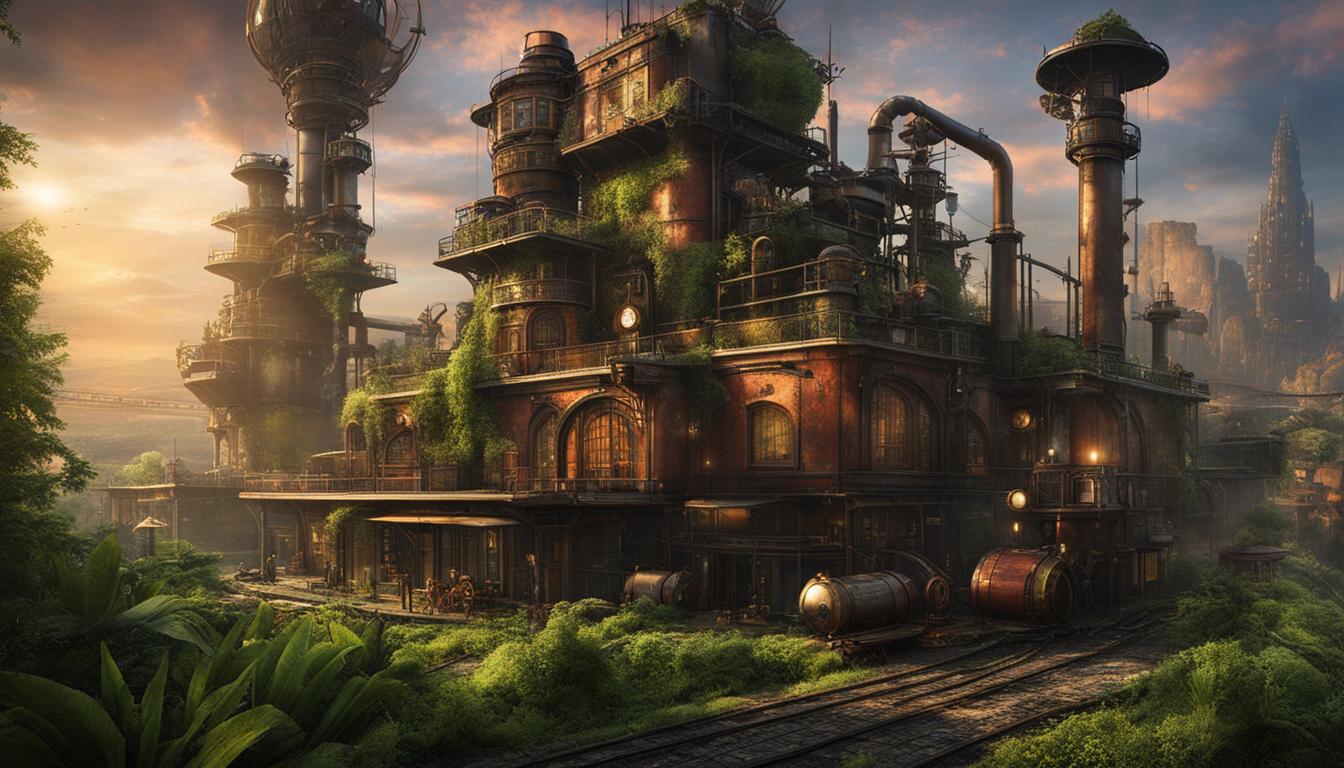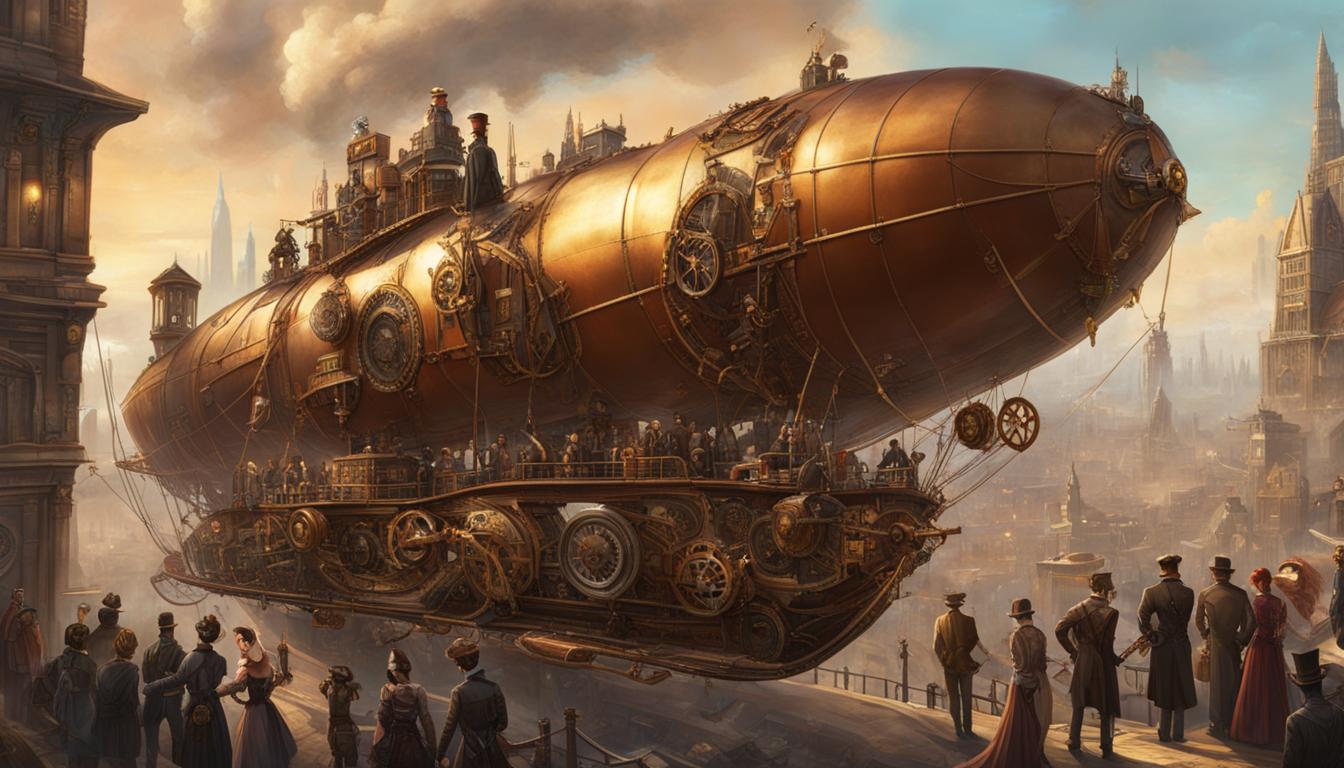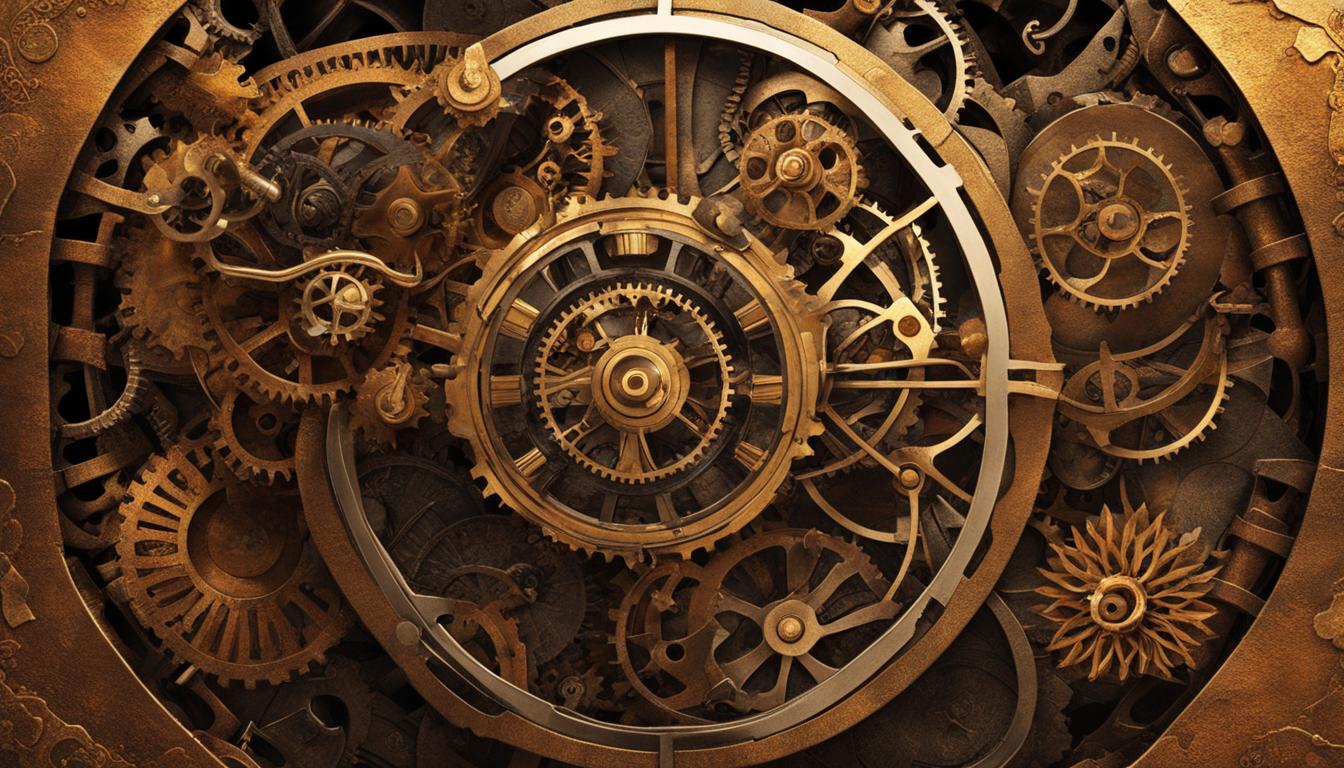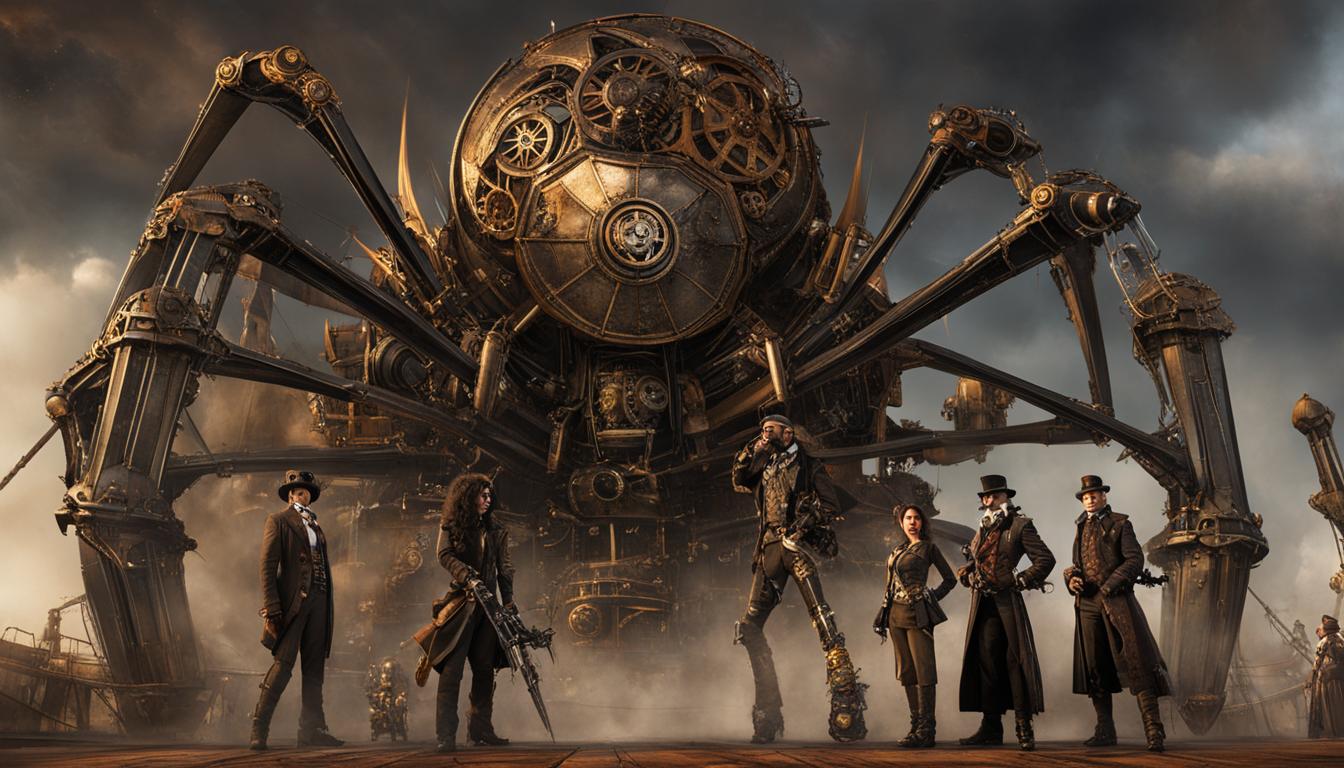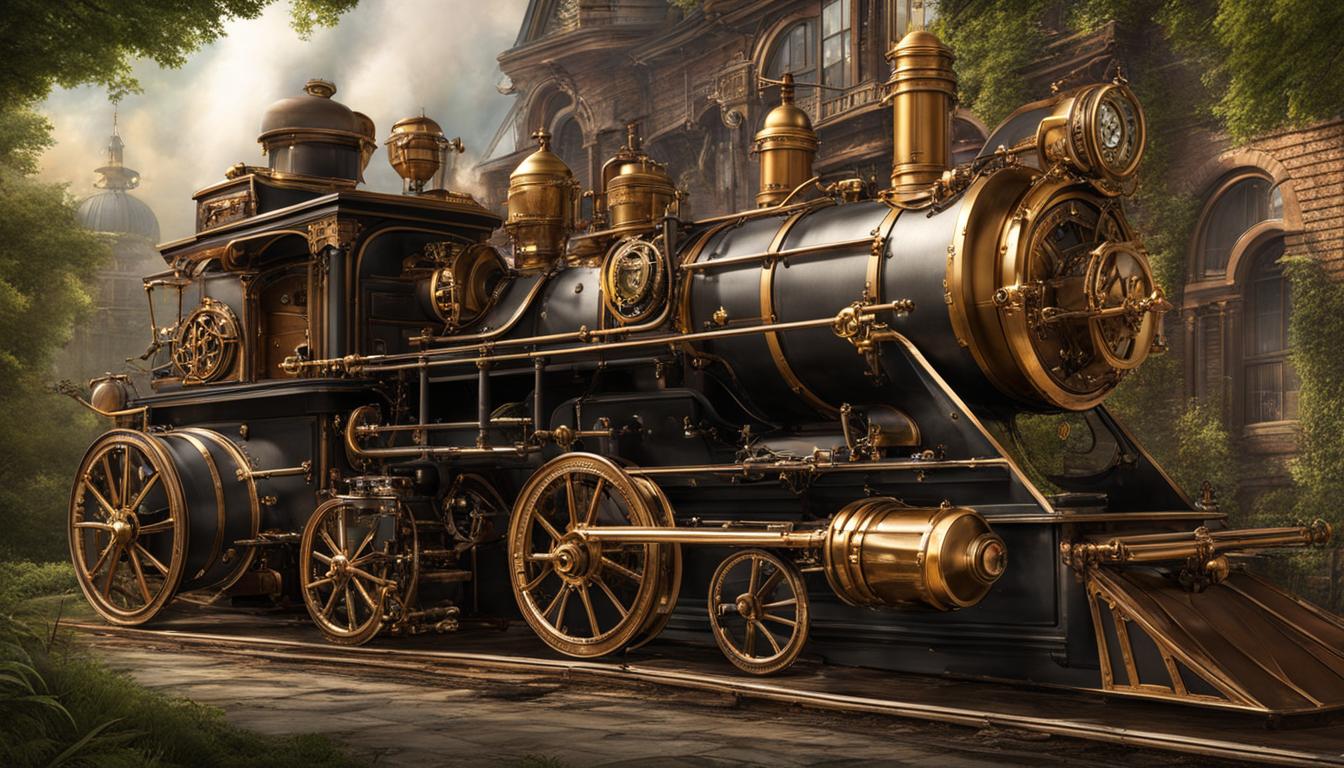Steampunk, the captivating subgenre of science fiction, invites us into a world of alternative realities, where hope and despair clash in a delicate dance. In this comparative study, we embark on an exploration of the contrasting views of dystopia and utopia that permeate the realm of steampunk.
Within the realm of steampunk literature, a fascinating interplay between utopian and dystopian elements emerges, presenting us with a multifaceted tapestry of narratives. Some works lean towards utopian visions, while others delve deep into the realms of dystopia. In this intriguing analysis, we unravel the themes, narratives, and philosophical stances that underpin steampunk’s dual views on the future.
Key Takeaways:
- Steampunk literature presents contrasting views of dystopia and utopia.
- Themes, narratives, and philosophical stances shape steampunk’s portrayal of utopian and dystopian worlds.
- Steampunk narratives oscillate between utopian and dystopian discourses, depicting various attitudes towards history, technology, and society.
- The delicate balance between hope and despair is a central theme in steampunk literature.
- Post-apocalyptic steampunk worlds offer dichotomous visions of utopia and dystopia, exploring the sacred and the profane.
The Oscillation Between Utopian and Dystopian Discourses in Steampunk
Steampunk, as a genre of science fiction, is known for its unique portrayal of alternative realities that incorporate both utopian and dystopian elements. In the world of steampunk literature, there is a constant oscillation between utopian and dystopian discourses, presenting contrasting views on the representation of history, technology, and society.
Some steampunk works, particularly American novels, tend to lean towards utopian visions. These narratives often envision flexible histories and progress, emphasizing the potential for a better future. For example, “The Difference Engine” by William Gibson and Bruce Sterling explores the concept of a steam-powered information age, where technology has transformed society into a utopia of progress and innovation.
On the other hand, Russian steampunk texts tend to gravitate towards dystopian perspectives. These narratives often portray histories resistant to change, highlighting the darker aspects of society and the dangers of unchecked technological advancement. “The Blizzard” by Vladimir Sorokin, for instance, depicts a harsh and desolate world where technology has failed to bring about positive change, resulting in a dystopian society struggling to survive.
Steampunk literature challenges the notion of a singular future by presenting a range of utopian and dystopian narratives that delve into the complexities of human progress and societal structures.
The oscillation between utopian and dystopian discourses in steampunk offers a thought-provoking exploration of contrasting attitudes towards the future. It invites readers to question the implications of technology, society, and history, and how these elements shape our understanding of utopia and dystopia. By analyzing specific works within the genre, we can gain a deeper understanding of steampunk’s critique of utopian societies and its depiction of dystopian worlds.
The Contrasting Attitudes of Steampunk
The contrasting attitudes of utopia and dystopia in steampunk literature reflect the complex nature of the genre. While some narratives lean towards utopian visions, emphasizing the potential for progress and innovation, others delve into dystopian themes, cautioning against the dangers of unchecked technological advancement.
Through this oscillation between utopian and dystopian discourses, steampunk challenges the notion of a singular future and invites readers to consider the implications of human progress and societal structures. It raises questions about the balance between hope and despair, and how these contrasting attitudes shape our understanding of the world we live in.
In the next section, we will delve further into the philosophical stance of steampunk literature, exploring the delicate balance between hope and despair and the portrayal of dystopian elements and critique of utopian societies.
Balancing Hope and Despair: Steampunk’s Philosophical Stance
Steampunk literature captures the imagination with its dystopian themes and vivid depictions of alternative worlds. However, beneath the surface of these dystopian landscapes, there is a delicate balance between hope and despair. Steampunk narratives explore the philosophical stance of the genre towards technological progress, human manipulation, and the consequences of emerging cybertechnologies.
One notable example is “Neuromancer” by William Gibson, a cyberpunk novel that delves into the dark underbelly of a technologically advanced society. The story follows the protagonist, Case, a washed-up computer hacker who is given a chance at redemption through a dangerous mission. As the narrative unfolds, the reader is confronted with a dystopian vision of a world where technology has become a tool for control and manipulation.
“The future is already here. It’s just not evenly distributed.”
Another thought-provoking work, “Homo Zapiens” by Victor Pelevin, explores the impact of consumerism and virtual reality on society. The novel presents a dystopian world where individuals become entangled in a virtual realm, losing touch with reality. Through its satirical portrayal of a hyper-capitalist society, “Homo Zapiens” raises questions about the consequences of unchecked technological progress and the fragmentation of human identity.
Table: Comparing Themes in Key Steampunk Works
| Steampunk Work | Dystopian Themes | Philosophical Stance |
|---|---|---|
| “Neuromancer” by William Gibson | Technological control and manipulation | Critical examination of the consequences of advanced technology |
| “Homo Zapiens” by Victor Pelevin | Consumerism and virtual reality | Reflection on the impact of consumer culture and the loss of human connection |
The Dichotomy of Utopia and Dystopia in Steampunk’s Post-Apocalyptic Worlds
Steampunk literature immerses readers in a unique blend of utopian visions and dystopian scenarios within post-apocalyptic worlds. The genre’s exploration of this dichotomy sheds light on humanity’s hopes and fears in the face of societal collapse and technological advancements. Steampunk’s critique of utopian societies and its depiction of dystopian landscapes offer thought-provoking insights into the delicate balance between progress and decline.
One notable example is Walter Miller’s “A Canticle for Leibowitz,” which examines a post-apocalyptic future where a monastic order preserves knowledge amidst a devastated world. While this work presents a utopian vision of a revived and sacred society, it also critiques the failures and dangers of blind faith in progress. Miller highlights the delicate interplay between the pursuit of utopia and the potential for dystopia.
Contrasting the American perspective, Russian steampunk works like Georgii Daneliia’s “Kin-Dza-Dza!” and Dmitry Glukhovsky’s “Metro 2033” predominantly depict dystopian scenarios. These narratives challenge the notion of a utopian future, emphasizing the disenchantment and despair that arise in the aftermath of catastrophe. By subverting traditional utopian ideals, Russian steampunk offers a critical analysis of societal collapse and the struggle for survival.
| Steampunk Work | Utopian Vision | Dystopian Portrayal |
|---|---|---|
| “A Canticle for Leibowitz” by Walter Miller | Revived sacred society | Critique of blind faith in progress |
| “Kin-Dza-Dza!” by Georgii Daneliia | Disenchantment with utopian ideals | Dystopian struggle for survival |
| “Metro 2033” by Dmitry Glukhovsky | Challenging the notion of utopia | Depiction of post-apocalyptic despair |
These contrasting visions of utopia and dystopia in steampunk’s post-apocalyptic genre reflect the genre’s ability to challenge societal norms and provoke thoughtful analysis. The delicate balance between hope and despair, progress and decline, offers readers a complex exploration of humanity’s aspirations and pitfalls. Steampunk’s ability to navigate this dichotomy has solidified its place as a genre that is both intellectually engaging and visually captivating.
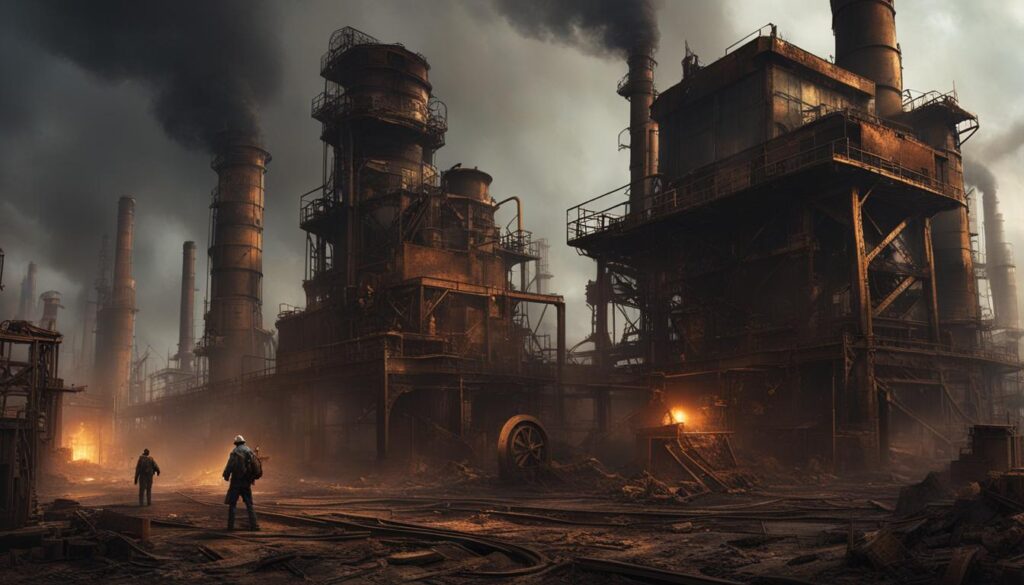
Conclusion
As the world of steampunk unfolds, it takes us on a journey through contrasting views of utopia and dystopia. Steampunk effortlessly balances the scales of hope and despair, weaving together narratives that oscillate between utopian dreams and dystopian nightmares. This subgenre of science fiction not only critiques utopian societies but also envisions utopian ideals, presenting a philosophical stance on the complexities of the human condition.
By delving into specific works and exploring their themes, narratives, and philosophical stances, this comparative study reveals the intricate portrayal of utopia and dystopia in steampunk literature. Through its exploration of technological progress, human manipulation, and emerging cybertechnologies, steampunk prompts us to reflect on our own societal aspirations and pitfalls.
Steampunk’s philosophical stance on utopias and dystopias reflects broader tendencies in the postmodernist movement, inviting us to question the very fabric of our own reality. It challenges us to examine our desires for a perfect world while acknowledging the darker corners of our existence. Steampunk provides a powerful platform for contemplating the delicate interplay between hope and despair, ultimately leaving us with a profound sense of wonder and intrigue.
FAQ
What is steampunk?
Steampunk is a subgenre of science fiction that presents alternative realities incorporating both utopian and dystopian elements. It often explores themes of history, technology, and society.
How does steampunk balance hope and despair?
Steampunk narratives oscillate between utopian and dystopian discourses, presenting contrasting views on the representation of history, technology, and society. This balance creates a philosophical stance that critiques utopian societies while also envisioning utopian ideals.
Are there different perspectives on utopia and dystopia in steampunk literature?
Yes, steampunk literature showcases contrasting attitudes and discourses of utopia and dystopia. American novels tend to lean towards utopian visions, while Russian steampunk texts often gravitate towards dystopian perspectives.
How does steampunk explore the delicate balance between hope and despair?
Steampunk literature examines the philosophical stance of the genre towards technological progress, human manipulation, and emerging cybertechnologies. It delves into the portrayal of dystopian elements and offers a critique of utopian societies.
How does steampunk depict post-apocalyptic worlds?
In post-apocalyptic settings, steampunk works showcase different views on the dialectic of the sacred and the profane. American narratives often root their post-apocalyptic worlds in revived mythical times, hoping for the attainment of the sacred. Russian narratives predominantly depict dystopian scenarios and exhibit a disenchantment with the sacred.
What does steampunk’s depiction of utopia and dystopia say about societal aspirations and pitfalls?
Steampunk’s philosophical stance on utopias and dystopias reflects broader tendencies in the postmodernist movement. It provokes thought about our own societal aspirations and pitfalls, encouraging us to examine our desires for utopian ideals while remaining aware of the potential dystopian consequences.

